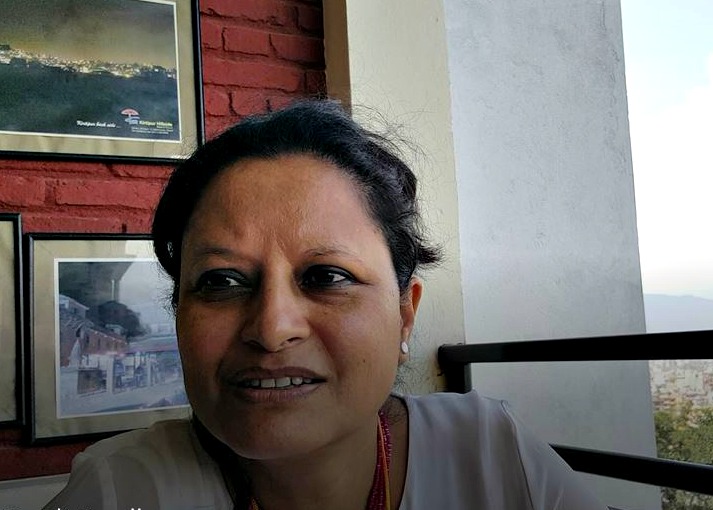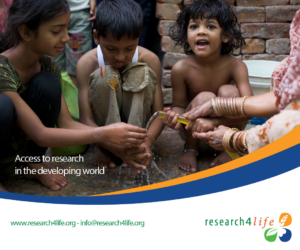For Open Access Week, we decided to broaden the pool of contributors to our regular “Ask the Chefs” column. As we think about open research and equity, we introduce a new type of post: “Ask the Community”, where we invite others to answer the same question put to the Chefs, with a deliberate focus on some of the people or regions of the world that often are disadvantaged in the global research landscape. This post is in two parts, today’s responses from people involved in enabling access, in libraries or as journal editors and publishers; tomorrow we will hand over to some of those most expected to benefit from open access, researchers, and also think about the role of policymakers in open research.

Jesca Karungi, Chairperson, Consortium of Uganda University Libraries (CUUL), Uganda
In order to achieve equitable participation in open research there is a need for access, and so internet bandwidth is a serious concern for researchers in countries such as Uganda. Most active players in Africa are handicapped because of intermittent network drops, very slow internet connection speeds and lack of up-to-date access devices. Therefore, to effectively ensure participation in open access (OA), there is need to redirect funding into boosting internet access and up-to-date access to tools for libraries to loan to their users. Much as OA ensures that research outputs are shared to benefit communities that cannot afford paid content, this noble goal can only be achieved if the enabling environment at the academic libraries is provided. Librarians must also be trained in OA participation concerns in order to ensure ethical issues adherence and effective OA promotion.
Josiline Chigwada, Sub Librarian – Information Services, Bindura University of Science Education, Zimbabwe
 We can achieve equitable participation in open research by creating awareness of the importance of ensuring equal access to research output among researchers and demystifying myths surrounding OA. Most researchers do not understand much about OA, leading to various views and perceptions towards the subject. Librarians, therefore, have a big role to play in ensuring that there is equitable participation in open research. This can be done by building capacity and educating researchers on the importance and benefits of OA as a way of encouraging researchers to participate towards open research and open science.
We can achieve equitable participation in open research by creating awareness of the importance of ensuring equal access to research output among researchers and demystifying myths surrounding OA. Most researchers do not understand much about OA, leading to various views and perceptions towards the subject. Librarians, therefore, have a big role to play in ensuring that there is equitable participation in open research. This can be done by building capacity and educating researchers on the importance and benefits of OA as a way of encouraging researchers to participate towards open research and open science.
Librarians at Bindura University of Science Education (BUSE) engage in various activities to promote open research and we join the rest of the world in commemorating the annual International Open Access Week. A recent highlight was our 2016 Open Access Week celebrations, which concluded with the signing of the Berlin Declaration by our Vice Chancellor.
This year, the following activities are going on:
- Display at the library foyer showcasing OA resources that can be used by library patrons during research; banners and posters are being displayed and brochures distributed to visitors who come to the OA stand.
- An OA lecture for undergraduate students including a question and answer session with prizes for the participants.
- Use of social media platforms (twitter and Facebook) to provide updates on the activities taking place throughout the week.
- A webpage on the library website showcasing the activities lined up for the Open Access Week.
Our library has also used other approaches to create awareness of OA and demystify the myths. These have included: talking about open research in meetings and informally as a way of using word of mouth to spread information; holding seminars and workshops and inviting influential people to talk about OA; building and populating the institutional repository; engaging library ambassadors in the form of students and staff who are knowledgeable about library issues and events so that they can spread the word to the other students; and teaching students about open research during information literacy training. OA is also part of the information literacy module that is offered to all the first-year students at BUSE.
Dr Eli Pradhan, ophthalmologist, researcher and Chief Editor of Nepalese Journal of Ophthalmology, Nepal
 The Nepalese Journal of Ophthalmology is an OA journal with easy access for authors, readers, and scientists to view our articles at any time. As part of the Nepal Journals Online (NepJOL) platform, it has wide visibility too. This is the only journal that deals with ophthalmology in our country and we have authors from different parts of the world, for example India, Pakistan, Turkey and Australia. We have no article processing charges (APCs) and are indexed in Pubmed so people feel more secure submitting to our journal.
The Nepalese Journal of Ophthalmology is an OA journal with easy access for authors, readers, and scientists to view our articles at any time. As part of the Nepal Journals Online (NepJOL) platform, it has wide visibility too. This is the only journal that deals with ophthalmology in our country and we have authors from different parts of the world, for example India, Pakistan, Turkey and Australia. We have no article processing charges (APCs) and are indexed in Pubmed so people feel more secure submitting to our journal.
We have a very clear concept of OA as the practice of free access of peer-reviewed scholarly research, literature or work to all readers, who are interested. It is also the fundamental base for the development of new scientific research when the concept is distributed equally to everyone who is interested to partake in new studies.
OA creates a healthy environment for the authors and readers – and having an OA policy moves away from the traditional idea of researchers being conservative about sharing their ideas and knowledge about their work. However, for editors, the workload remains the same. This is difficult in Nepal because being an editor is entirely a volunteer job with long hours dedicated to the journal each day to keep up the standard. Many journals in Nepal struggle due to lack of a dedicated working team. Therefore, there has to be some kind of reward for hard-working editors too.
Dr Haseeb Md Irfanullah, aquatic ecologist, editorial board member for Bangladesh Journal of Plant Taxonomy and editorial advisory committee member for APN Science Bulletin, Bangladesh
I always find it intriguing how, without using the term ‘Open Access’, many academic journals from developing nations have adopted this model since their inception, often many decades back. Many business models have evolved in the academic publishing world, but these journals maintained their authorship and readership more or less the same, perhaps only expanding to neighboring countries with similar economies.
The reason is simple: the publication costs of these journals are essentially covered by the host institutions or the publishers and/or by the national government. This is only possible because the cost of publication is very low in these countries, and the editorial office is run by volunteer editors doing multi-tasking. They may talk about subscriptions, but this is often only for the printed copies and, as these journals are now increasingly available online, such a subscription model becomes meaningless. Even if these journals ask for APCs, it is often quite minimal, and only to cover the actual costs of color plates or paper reprints, for example.
It may be argued that journals published by developing countries’ societies and those published by reputed, leading publishers vary a lot in terms of quality, outreach, and impact, although many from both streams find their ways into the JCR or other esteemed indexing systems. However, if our national agencies (i.e., universities and research organizations) accept publications that are in locally published, low-cost, but OA journals indexed by reputed international agencies, are we creating our own world that could be isolated from the much larger, global academic arena?
And how does this ‘developing country model’ I have described compare with, for example, ‘hybrid OA’ – the model a significant portion of journals/publishers are now following?
When we talk about equitable participation in open research, should we not talk about the islands of developing countries’ academic journal publishing in the global academic publishing ocean? Are they facilitating/promoting or hindering equity in open research?
Alison Mudditt, Scholarly Kitchen Chef, CEO the Public Library of Science (PLOS)
While I’m enormously proud of the achievements of OA (a recent study shows close to 50% of research is available through some form of OA), I’m increasingly concerned about a model that risks replicating the costs and structural inequities of the subscription model we’re trying to replace: the pay-to-read barrier is being replaced by a pay-to-publish barrier. Research has demonstrated that authors working at lower-ranked universities are more likely to publish in closed/paywalled outlets, while those affiliated with high-ranked universities and well-funded institutions have more resources to choose OA options. And it’s even more of a concern for the Global South where APCs reinforce the existing unequal representation of research from these regions in the global knowledge production and publishing systems.
That said, I don’t have easy answers – a return to reader paywalls is not the solution. Most importantly, there has to be a concerted effort to experiment with new business models that don’t rely on APCs. We’re actively working on this at PLOS and will be launching our first pilots in 2019. There’s also a key role for libraries and institutions here. Currently, the funding for scholarly communication sits in two main places: with funders and with libraries. For publishers like PLOS to successfully develop more inclusive models, we need libraries to be prepared to move dollars from subscriptions in significant quantities if new models are to scale and succeed. Pricing also has to be a part of this – we need to work with our communities to develop fair, transparent pricing that expands the total value pool for all participants.
The second target has to be the development of community infrastructure to support open research, both for and beyond the article. Many of us have been concerned to see key pieces of infrastructure acquired by commercial competitors with a clear bet on value chain integration. But the non-profit space is challenged by the sheer number of distinct entities innovating in specific areas of the open research space. And while there are a few initiatives seeking to join this together – such as the 2.5% Commitment and the new Joint Roadmap for Open Science Tools – as Cameron Neylon has pointed out, these collective action problems are notoriously hard to solve. Cameron suggests a shift to a clearer, pragmatic investment-style approach (Nature’s spin-off of Digital Science is perhaps an interesting model) but whatever the answer, there’s too much at stake for us not to solve this one.
Continued in Part Two.
Discussion
1 Thought on "Ask the Community (and Chefs): How Can We Achieve Equitable Participation in Open Research?"
Thanks Sian, excellent and eye opening, helps put OA week into a larger global context



